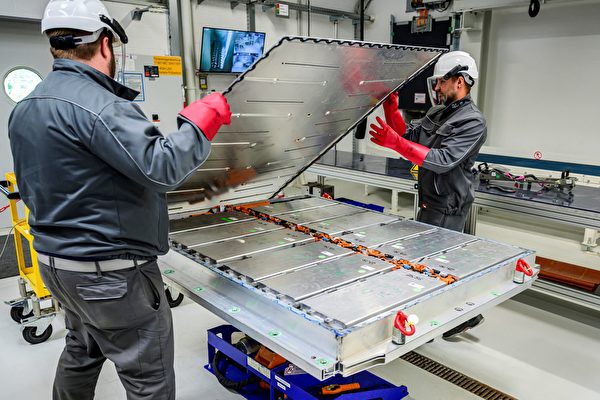In recent years, the electric vehicle and “green energy” industries have been developing rapidly. However, electric vehicles not only require a large amount of lithium batteries but also generate a significant amount of battery waste and toxic substances.
To promote “green energy,” the European Union established a plan in 2022 requiring all new cars and trucks sold in the EU to no longer emit carbon dioxide after 2035. This means that the sale of vehicles using fossil fuels will be prohibited in 2035. This has prompted European and American car manufacturers to develop new energy vehicles to comply with strict environmental regulations.
However, as the lithium batteries used in these electric vehicles age and deteriorate, there is a growing concern about the accumulation of low-quality electric vehicles being discarded, leading to the challenge of how to properly handle this waste of lithium batteries.
According to some statistics, the global market value of lithium batteries is estimated to exceed $500 billion, with projections to grow to over $1 trillion in the next decade.
Currently, many manufacturers and scientists are conducting research on lithium battery recycling in hopes of properly recovering and reusing these discarded batteries to reduce environmental pollution. A report from Research And Markets last month estimated the global lithium battery recycling market value at $7.3 billion in 2024, with expectations to reach $23.9 billion by 2030.
Research from the Institute for Energy Research (IER) shows that globally, less than 10% of lithium batteries are properly recycled, in sharp contrast to the 99% recycling rate of lead-acid batteries in the United States. The toxic pollutants within lithium batteries, including lithium, cobalt, manganese, nickel, and iron phosphate, could potentially seep into soil and groundwater, posing risks to human living environments, health, and drinking water.
Currently, manufacturers, scientists, and governments are researching and implementing regulations for lithium battery recycling with the hope of efficiently recovering and reusing these waste batteries to prevent them from entering general waste streams and further contributing to environmental pollution.
However, the current recycling rate in the recycling market is still far below the global demand for manufacturing lithium batteries. This is due to the complexity and cost of the lithium battery separation process. Battery manufacturers have found that while the prices of these metals are rapidly rising, the cost of recycling these metals remains higher than using new metals.
There are currently four main methods of lithium battery recycling:
1. Pyrometallurgical method: using temperatures of 1000℃ to reduce metal oxides back to cobalt, copper, iron, nickel, and other alloys. However, this method is highly energy-intensive, produces toxic gases, and has a material recovery rate of only about 50%.
2. Hydrometallurgical method: using chemical solutions to precipitate metals from lithium batteries. However, this method requires large solvent quantities and slow processes, which if improperly handled, can lead to significant environmental pollution.
3. Direct recycling method: involves adjusting the cathode and anode materials of batteries and supplementing with lithium metal to reduce the purification steps. However, this method is sensitive to pollution and the technology is not yet mature.
4. Battery Recycling and Water Splitting (BRAWS) technology: using water and carbon dioxide to recover lithium and generate green hydrogen as a byproduct to further reduce environmental impacts. However, research on this method is still limited.
The primary method of lithium battery recycling is to send the batteries to electronic retailers or hazardous waste collection points to avoid them being buried or incinerated as general waste. These recycling businesses refine and purify the useful metals such as lithium, cobalt, manganese, and nickel from the discarded batteries for sale and reuse.
However, the processes of refining and purifying these waste lithium batteries are similar to the extraction of new lithium metal and require a substantial amount of energy, chemicals, and freshwater consumption, which can also contribute to environmental pollution. Improper handling of recycled lithium batteries may also lead to short circuits, fire hazards, and the release of toxic gases.
In recent years, the People’s Republic of China has been heavily promoting the development of new energy vehicles to achieve its “Made in China 2025” initiative. To support the domestic new energy vehicle industry, China has implemented extensive government subsidies to assist these car manufacturers in developing electric vehicles. However, as time has passed, more and more Chinese new energy vehicle companies have gone out of business, leading to the accumulation of a large number of electric vehicle graveyards. Currently, there are less than 10 remaining car manufacturers in China, who may struggle to survive without the substantial government subsidy policies.
However, these domestically produced vehicles have many quality issues, such as design flaws, brake malfunctions, chassis corrosion susceptibility, insufficient battery life, leakage, battery fires, non-compliant bumper and post collision factors, as well as frequent disruptions in intelligent panel and autonomous driving systems. As a result, many vehicle owners opt to resell, abandon, or scrap their electric vehicles, leading to the generation of a significant amount of waste and retired lithium batteries.
The cost of repairing electric vehicles and replacing new lithium batteries may be higher than purchasing a new vehicle, and the depreciation value of many electric vehicles is lower than that of conventional cars.
Furthermore, in order to qualify for Chinese government subsidies, Chinese auto manufacturers have cooperated with the government to dump a large number of low-priced electric vehicles in foreign countries, leading to a backlog of electric vehicles in European ports. Many of these vehicles are returned by other countries due to quality issues.

